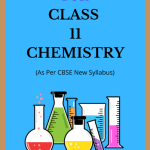NCERT Class 11 Chemistry Chapter 5 States of Matter: Gases, Liquids and Solids Solutions to each chapter is provided in the list so that you can easily browse through different chapters NCERT Class 11 Chemistry Chapter 5 States of Matter: Gases, Liquids and Solids and select need one. NCERT Class 11 Chemistry Chapter 5 States of Matter: Gases, Liquids and Solids Question Answers Download PDF. NCERT Chemistry Class 11 Solutions.
NCERT Class 11 Chemistry Chapter 5 States of Matter: Gases, Liquids and Solids
Also, you can read the NCERT book online in these sections Solutions by Expert Teachers as per Central Board of Secondary Education (CBSE) Book guidelines. NCERT Class 11 Chemistry Chapter 5 States of Matter: Gases, Liquids and Solids Solutions are part of All Subject Solutions. Here we have given NCERT Class 11 Chemistry Part: I, Part: II Notes. NCERT Class 11 Chemistry Chapter 5 States of Matter: Gases, Liquids and Solids Notes, NCERT Class 11 Chemistry Textbook Solutions for All Chapters, You can practice these here.
States of Matter: Gases, Liquids and Solids
Chapter: 5
| Part – I |
1. What will be the minimum pressure required to compress 500 dm3 of air at 1 bar to 200 dm3 at 30°C?
Ans: P1 = 1 bar
V1 = 500 dm³
P2 = ?
V2 = 200 dm³
By rearranging the equation:
P2 = P1×V1/V2
Substituting the values:
P2 = 1 × 500/200
= 2.5 bar
Thus, the minimum pressure required to compress the air to 200 dm³ is 2.5 bar.
2. A vessel of 120 mL capacity contains a certain amount of gas at 35°C and 1.2 bar pressure. The gas is transferred to another vessel of volume 180 mL at 35°C. What would be its pressure?
Ans: P1 = 1.2bar
V1 = 120 mL
V2 = 180 mL
P2 = ?
P2 = (P1×V1)/V2
P2 = (1.2bar × 120mL)/180ml
= 144/180
= 0.8bar
3. Using the equation of state PV = nRT, show that at a given temperature, density of a gas is proportional to the gas pressure P.
Ans: P = pressure of the gas.
V = volume of the gas.
n = number of moles of the gas.
R = ideal gas constant.
T = temperature of the gas.
4. At 0°C, the density of a gaseous oxide at 2 bar is same as that of dinitrogen at 5 bar. What is the molecular mass of the oxide?
Ans: Using the expression, d = MP/RT, at the same temperature and for same density,
M1 is the molar mass of the gaseous oxide.
P1 = 2bar (pressure of the oxide).
M2 = 28u (molecular mass of nitrogen N2).
P2 = 5bar (pressure of nitrogen N2).
5. Pressure of l g of an ideal gas A at 27°C is found to be 2 bar. When 2 g of another ideal gas B is introduced in the same flask at the same temperature, the pressure becomes 3 bar. Find the relationship between their molecular masses.
Ans: Suppose molecular masses of A and B are MA and MB respectively. Then their number of moles will be:
nA = 1/MA,
nB = 2/MB
PA = 2bar
PA + PB = 3 bar,
I.e., PB = 1 bar
Applying the relation PV = nRT
6. The drain cleaner, Drainex contains small bits of aluminium which react with caustic soda to produce dihydrogen. What volume of dihydrogen at 20 °C and one bar will be released when 0.15g of aluminium reacts?
Ans: Aluminium react with caustic soda (NaOH) in accordance with the reaction
2Al(s) + 2NaOH(aq) + 6H2O(l) → 2Na[Al(OH)4](aq) + 3H2(g)
2 × 27g 3 mol
= 54g 3 × 22.4L
This equation shows that 2 moles of aluminium produce 3 moles of dihydrogen (H2).
= 1.187 L
= 187 mL
P1 = 1 bar, p2 = 1 bar
T1 = 273 K
T2 = 20∘C = 293 K
V1 = 187 ml
V2 = ?
According to Gas equation
V1/T1 = V2/T2
187mL/273 K = V2/293K
Or V2 = (187 × 293) / 273
= 200.5ml
= 20.3L
The volume of dihydrogen released at 20°C and 1 bar is approximately 20.3 L.
7. What will be the pressure exerted by a mixture of 3.2g of methane and 4.4g of carbon dioxide contained in a 9 dm3 flask at 27 °C?
Ams: Mass of methane (CH₄) = 3.2 g
Molar mass of methane = 16 g/mol
Mass of carbon dioxide = 4.4 g
Molar mass of carbon dioxide = 44 g/mol
Amount of methane,
8. What will be the pressure of the gas mixture when 0.5 L of H2 at 0.8 bar and 2.0 L of dioxygen at 0.7 bar are introduced in all vessels at 27 °C?
Ans: pV = nRT
Initial conditions for hydrogen (H2)
Volume V1 = 0.5 L
Pressure P1 = 0.8 bar
Final volume V2 = 1.0 L
Initial conditions for dioxygen (O2)
Volume V′ = 2.0 L
Pressure P1′ = 0.7 bar
Final volume V2= 1.0 L
Calculation the partial pressure of hydrogen (PH2)
P1V1 = P2V2
(0.8bar) × (0.5L) = P2 × (1.0L)
P2 = 0.8 × 0.5 / 1.0
= 0.4bar
Calculation the partial pressure of dioxygen (PO2)
P1′V1′ = P2′V2′
(0.7bar) × (2.0L) = P2′ × (1.0L)
P2′ = 0.7 × 2.0/1.0 = 1.4bar
Calculation of total pressure
Ptotal = 0.40bar + 1.4bar = 1.8bar
9. Density of a gas is found to be 5.46 g/dm3 at 27 °C and at 2 bar pressure. What will be its density at STP?
Ans: d1 = 5.46g/dm3
P1 = 2 bar
T1 = 27∘C = 300K (since T (K) = T (∘C) + 273T)
At STP, P2 = 1 bar and T2 = 273 K
10. 34.05 mL of phosphorus vapour weighs 0.0625 g at 546°C and 1.0 bar pressure. What is the molar mass of phosphorus?
Ans: PV = nRT
Mass of phosphorus vapours (W) = 0.0625 g
Volume (V) = 34.05 mL = 34.05 × 10 − 334.05
Pressure (P) = 1 bar
Gas constant (R) = 0.0830.0830.083 bar·L·K⁻¹·mol⁻¹
Temperature (T) = 546∘C + 273 = 819K
M = (0.0625 × 0.083 × 819)/(1 × 34.05 × 10−3)
M = 4.248/0.03405
= 124.78g/mol
11. A student forgot to add the reaction mixture to the round bottomed flask at 27 °C but instead, he/she placed the flask on the flame. After a lapse of time, he realised his mistake, and using a pyrometer, he found the temperature of the flask was 477 °C. What fraction of air would have been expelled out?
Ans: Initial volume of air in the flask = V cm3
Initial temperature, T1 = 27∘C = 300 K
Final temperature, T2 = 750 K
Volume of the air changes due to heating.
T1 = 27 + 273 = 300k
T2 = 477 + 273 = 750k
Thus, the final volume of air is 2.5V cm3.
Volume expelled = V2 − V = 2.5V − V = 1.5V
Fraction of air expelled= 1.5V/2.5V = 3/5
12. Calculate the temperature of 4.0 moles of a gas occupying 5 dm3 at 3.32 bar (R = 0.083 bar dm3 K-1 mol-1)
Ans: p = Pressure of the gas = 3.32 bar
V = Volume of the gas = 5 m3
n = Amount of gas = 4 mol
R = Gas constant = 0.083 bar\cdot pm3⋅K−1⋅mol−1
T = 16.6/0.332
= 50k
Thus, the temperature of the gas is 50 K.
13. Calculate the total number of electrons present in 1.4 g of dinitrogen gas.
Ans: Molar mass of dinitrogen (N2) = 28g mol−1
28 g of N2 has No. of molecules = 6.022 × 1023 1.4 g of
N2 has No. of molecules = 6.022 × 1023 × 1.4 g/28 g
= 3.011 × 1022 molecules.
Atomic number of nitrogen (N) = 7
1 molecule of N2 has electrons
= 7 × 2 = 14
3.011 × 1022 molecules of N2 have electrons
= 4 × 3.011 × 1022
= 4.215 × 1023 electrons.
Thus, 4.214 × 10²³ electrons are present in 1.4 g of dinitrogen gas.
14. How much time would it take to distribute one Avogadro number of wheat grains if 1010 grains are distributed each second?
Ans: Time taken to distribute 1010 gains = 1s
Time taken to distribute = 6.02 × 1023
= 1.9 × 106 yr.
Hence, the time taken would be 1.9 × 106 yr.
15. Calculate the total pressure in a mixture of 8g of oxygen and 4g of hydrogen confined in a vessel of l dm3 at 27°C. R = 0.083 bar dm3 K-1 mol-1.
Ans: Mass of oxygen (mO2) = 8 g
Mass of hydrogen (mH2) = 4 g
Volume (V) = 1 dm³
Temperature (T = 27°C = 27 + 273.15 = 300.15 K
Gas constant (R) = 0.083 bar dm³ K⁻¹ mol⁻¹
Amount of O2 = 8g/(32g/mol)
= 0.25 mol.
Amount of H2 = 4g/2g/mol
= 2 mol
From the gas equation, pV = nRT
P × 1 dm3 = (0.25mol + 2 mol) × 0.083 bar dm3 k-1 × 300 K
p = 56.025 bar.
16. Payload is defined as the difference between the mass of displaced air and the mass of the balloon. Calculate the payload when a balloon of radius 10 m, mass 100 kg is filled with helium at 1.66 bar at 27°C. (Density of air = 1.2 kg m– 3 and R = 0.083 bar dm³ k–¹ mol–¹). Sol. Calculation of the mass of displaced
Ans: Radius of the balloon (r) = 10 m
Mass of the balloon (m balloon) = 100 kg
Pressure of helium (P) = 1.66 bar
Temperature (T) = 27°C = 300 K
Density of air (ρair) = 1.2 kg/m³
Gas constant for helium (R) = 0.083 bar dm³ K⁻¹ mol⁻¹
Volume of He filled at 1.66 bar and 27 °C = 4190.5 m³ Calculation of mass of He PV = RT = w RT
Total mass of the balloon alongwith He = 100 + 1117.5 = 1217.5 kg
Maximum mass of the air that can be displaced by balloon to go up = Volume × Density
= 4190.5 m³ × 1.2 kg m³ = 5028.6 kg
Payload = 5028.6 – 1217.5 kg = 3811.1 kg
17. Calculate the volume occupied by 8.8 g of CO2 at 31.1 °C and 1 bar pressure. R = 0.083 bar LK-1 mol-1
Ans: Mass of CO2 (m) = 8.8 g
Molar mass of CO2 = 44 g/mol
Temperature (T) = 31.1 °C = 31.1 + 273.15 = 304.25 K
Pressure (P) = 1 bar
Gas constant (R) = 0.083 bar L K⁻¹ mol⁻¹
18. 2.9 g of a gas at 95°C occupied the same volume as 0.184 g of dihydrogen at 17°C, at the same pressure. What is the molar mass of the gas?
Ans: Given data,
Mass of the gas = 2.9 g
Mass of dihydrogen, mH2=0.184 gm
Temperature of the gas, T1 = 95°C = 95 + 273.15 = 368.15 K
Temperature of dihydrogen, T2 = 17°C = 17 + 273.15 = 290.15 K
19. A mixture of dihydrogen and dioxygen at one bar pressure contains 20% by weight of dihydrogen. Calculate the partial pressure of dihydrogen.
Ans: Total pressure of the gas mixture = 1 bar
The mixture contains 20% by weight of dihydrogen.
and mass of oxygen in the mixture = 80 g
Mass of dihydrogen (H2) = 20 grams
Mass of dioxygen (O2) = 80 grams
The partial pressure of hydrogen is 0.8 bar.
20. What would be SI units of quantity PV2T2/n?
Ans: Therefore, the SI unit for quantity is given by
pV2T2/n = (Nm-2)(m3)(k)2/mol
= Nm4k2mol-1
21. In terms of Charle’s Law, explain why – 273oC is the lowest possible temperature?
Ans: The temperature -273°C (ork) is known as absolute zero temperature. Below this temperature, a substance cannot exist as a gas and change to the liquid state. This is because all gases get liquefied before reaching a temperature of – 273oC. Hence, it can be concluded that – 273oC is the lowest possible temperature.
22. Critical temperature for carbon dioxide and methane are 31.1°C and 81.9°C respectively. Which of these has stronger intermolecular forces and why?
Ans. The critical temperature values indicate that the attractive forces between carbon dioxide molecules are stronger compared to gases with lower critical temperatures, implying a higher intermolecular attraction in CO2. In fact, both are non- polar gases but the Van der Waals forces of attraction in carbon dioxide molecules are more because of greater molecular size.
23. Explain the physical significance of Van der Waals parameters.
Ans. The physical significance of van der waals parameter is:
(i) Van der Waals constant ‘a’: Its value is a measure of the magnitude of the attractive forces among the molecules of the gas. Greater the value of ‘a’, larger are the intermolecular forces of attraction.
(ii) The Van der Waals constant ‘b’ represents the effective size of gas molecules, equaling four times their actual volume. It is also known as the excluded volume or co-volume.
24. Calculate (i) root mean square speed, (ii) average speed and (iii) most probable speed of CO2 molecules at 700 Κ.
Ans: (i) Root Mean Square Speed (vrms):
Vrms = √3RT/M
For CO2,molar mass (M) = 44g mol-1 = 44 х 10-3 kg mol-1
Thus, the root means square speed of carbon dioxide molecules at 700 k is 629.92 ms-1
(ii)
(iii)
25. A sample of a gas contains 15 molecules with a speed of 3ms-1 25 molecules with a speed of 5ms-1 and 30 molecules with a speed of 8ms-1 Calculate root mean square speed of these molecules.
Ans:
= 6.187 ms-1.
26. Calculate the temperature at which the average speed of oxygen equals that of hydrogen at 20 K.
Ans: Given data,
TH2 = 20K,
Molar mass of O2 = 32 g/mol = 0.032 kg/mol
Molar mass of H2 = 2 g/mol = 0.002 kg/mo
Or T2 = 20 × 32 /2 = 320k
MH2 = 2 gmol-1
Mo2 = 32g mol-1.
27. Calculate the temperature at which the root mean square speed, average speed and the most probable speed of oxygen gas are all equal to 1500 ms-1.
Ans: Root mean square speed, Vrms = √3RT/M
Average speed,
Vavg = √8RT/π M
(i) Most probable speed,
= 2886K
∴ T for root mean square speed = 2886K.
(ii)
∴ T for the average speed = 3399k
(iii)
Hence, T for most probable speed = 4330 K.

Hi! my Name is Parimal Roy. I have completed my Bachelor’s degree in Philosophy (B.A.) from Silapathar General College. Currently, I am working as an HR Manager at Dev Library. It is a website that provides study materials for students from Class 3 to 12, including SCERT and NCERT notes. It also offers resources for BA, B.Com, B.Sc, and Computer Science, along with postgraduate notes. Besides study materials, the website has novels, eBooks, health and finance articles, biographies, quotes, and more.



